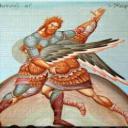Yahoo Answers is shutting down on May 4th, 2021 (Eastern Time) and beginning April 20th, 2021 (Eastern Time) the Yahoo Answers website will be in read-only mode. There will be no changes to other Yahoo properties or services, or your Yahoo account. You can find more information about the Yahoo Answers shutdown and how to download your data on this help page.
Trending News
does anyone who has gone to Okinawa beleive the naihanchi (Tekkei) kata were to protect the Okinawan King?
I keep hearing people talk about how Naihanchi Kata was made to protect the king of Okinawa in narrow castle corridors. When I ask if they have been to Shuri, they tell me that they have not. For those that have been, you have seen that there are not any narrow passages in the entire castle, do you think that the Naihanchi story is correct? If not, where do you unsupported idea came from?
To all Thanks so far I have heard those as well which sound a lot more plausable than the story I wrote about. I know that Motobu wrote that it was taught in Tomari, the Chinese and academic region of Okinawa at that time. He also said it was taught to Itosu Anko by a Chinese martial artist but the Kata no longer exists there. Funakoshi said it was taught to him by Azato Anko but renamed it in honor of Itosu. Both point away from the castle and to Tomari then China. I am curious where the myth above came from.
@ Sev
The Shuri "Castle" is more of a palace than a castle made for luxury rather than fightability. The true "outer wall" of Okinawa is that it is a coral island which made most ships that neared it need repairs if they were going to get home
6 Answers
- LiondancerLv 77 years agoFavorite Answer
In European castles there were narrow passages and stairways in order to be able to take on and fight one enemy at a time instead of having to fight multiple opponents.
Emperor residences in Asia tended to be huge so it was not easy to hide or get to the emperor without being seen in an attempt to assassinate. So no, I do not believe this story to be true. I also believe that the Naihanchi kata were a Chinese import like Kusanku and Chinto. I learned shorter 2 man forms in Shaolin Kung Fu that are similar to naihanchi.
- jwbulldogsLv 77 years ago
I have not trained in Okinawa. I have never heard this one. I have heard many. But I can tell you this is not true. It is only a myth. There is another myth that says the Naihanchi kata were created to fight on a ship on a plank were reasons for the sideways kata. However, if you learn more about bunkai you will understand the purpose of angle in kata. Thre is a relationship of angles. It is not about where the attack comes from, but the relationship is where you are when you apply the techniques. In the case of the Naihanchi kata you will be at your attackers side when applying the techniques. This kata has a lot of grappling in it.
Edit:
I understand there are a variety of myths surrounding the origin of this kata and why it is a sideways kata. Another theory is ti fight with your back against a wall. But again when you consider what angle mean in bunkai you will have a better understanding of how to apply the techniques of the kata. It will dispel some of the myths such as training or fighting in boats and planks. They just make for a good story.
Source(s): Martial Arts since 1982 - KokoroLv 77 years ago
i have done a lot of research into naihanchi but never came across that one.
naihanchi traces its roots back to a kung fu system, there were several possibility. it was not created to defend the castle any more then the pinan kata were. at least the pinan kata myth sounded more believable to me.
this was suppose to be a two man kata. now if you ever come across the other set to that kata do let me know.
Source(s): 30+yrs ma - GeorgieLv 57 years ago
Good question:)
The story is probably a myth..
It is much more likely to have being originally created by fishermen, to be able to protect their boats and their goods, while near to the shore by other people in boats, especially in places where a lot of boats were to be found near to the shore...In addition probably they were using it for training, while in the boat, since they were spending a lot of time in their boats.
The movements are indicating that, since stances are indicating that stability is less than normal, so more balance is needed, the moving to the right and to the left sideways indicates that their is some length but not so much width, so normally the scenery is a boat, that has some length and is narrow enough for someone to be able to row...
Later on obviously they have added different applications, in different places, according to their sceneries, but the original reason most probably was that, since the first form's applications, are most probably closer to how it looks, than the later additions and interpretations.
- How do you think about the answers? You can sign in to vote the answer.
- Darth ScandalousLv 77 years ago
I did Naihanchi for my Taiwanese teacher, and he said that it is a longer form from China, developed by Fisherman and Ferry owners. Their boats were narrow and they used Naihanchi's movement to keep their centerline aligned with the centerline of the boats. They can execute leg technique without tipping over their boats and losing their catch or goods.
I told him that is it a longer form but at the time I did not know the other sets.
Hokama Sensei said Naihanchin's name is Chinese and it is pronounced Dai Po Chien.
- SevLv 67 years ago
Versus a corridor, what about a threshold into a room?
EDIT: Ok so then that pretty much debunks my theory




